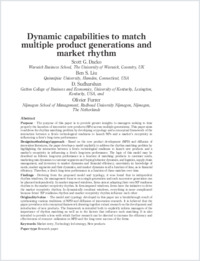Dynamic capabilities to match multiple product generations and market rhythm
Université de Fribourg
- Dacko, Scott G. University of Warwick
- Liu, Ben S Quinnipiac University
- Sudharshan, D. University of Kentucky
- Furrer, Olivier University of Fribourg / Nijmegen School of Management, Radboud University Nijmegen, Nijmegen, The Netherlands
-
2008
Published in:
- European Journal of Innovation. - 2008, vol. 11, no. 4, p. 441-471
English
Purpose : The purpose of this paper is to provide greater insights to managers seeking to time properly the launches of innovative new products (NPs) across multiple generations. This paper aims to address the rhythm matching problem by developing a typology and a conceptual framework of the interaction between a firm’s technological readiness to launch NPs and a market’s receptivity in influencing a firm’s long-term performance. Design/methodology/approach –:Based on the new product development (NPD) and diffusion of innovation literatures, the paper develops a model explicitly to address the rhythm matching problem by highlighting the interaction between a firm’s technological readiness to launch new products and a market’s receptivity in influencing a firm’s long-term performance. The logic of this model may be described as follows: long-term performance is a function of matching: products to customer needs, marketingmix dynamics to customer segments and buying behavior dynamics, and logistics, supply chain management, and inventory to market dynamics and financial efficiency; uncertainty in: knowledge of needs, market segments and their dynamics, and market dynamics is all a function of time, as is financial efficiency. Therefore, a firm’s long-term performance is a function of these matches over time. Findings : Deriving from the proposed model and typology, it was found that in independent rhythm windows, the management focus is on a single generation and each successive generation can be planned independently. In market- imposed windows, firms aim at adapting their own NP readiness rhythm to the market receptivity rhythm. In firm-imposed windows, firms have the initiative to drive the market receptivity rhythm. In dynamically resultant windows, everything is more complicated because firms’ NP readiness rhythm and market receptivity rhythm influence each other. Originality/value : The model and typology developed in this paper are a breakthrough result of synthesizing various traditions of NPD and diffusion of innovation research. It is believed that the paper provides a rich conceptual framework drawing together extant research on the development and introduction of new products. The framework is intended both to explicitly inform managers of the importance of rhythm matching as well as to the factors that influence such matching. It is also intended to provide a lens with which further research can be directed to increase the efficiency and effectiveness of resource utilization in NPD and the long- term success of the firms.
- Faculty
- Faculté des sciences économiques et sociales et du management
- Department
- Département des sciences du Management
- Language
-
- English
- Classification
- Economics
- License
-
License undefined
- Identifiers
-
- RERO DOC 232638
- DOI 10.1108/14601060810911110
- Persistent URL
- https://folia.unifr.ch/global/documents/303779
Statistics
Document views: 171
File downloads:
- Texte intégral: 278
